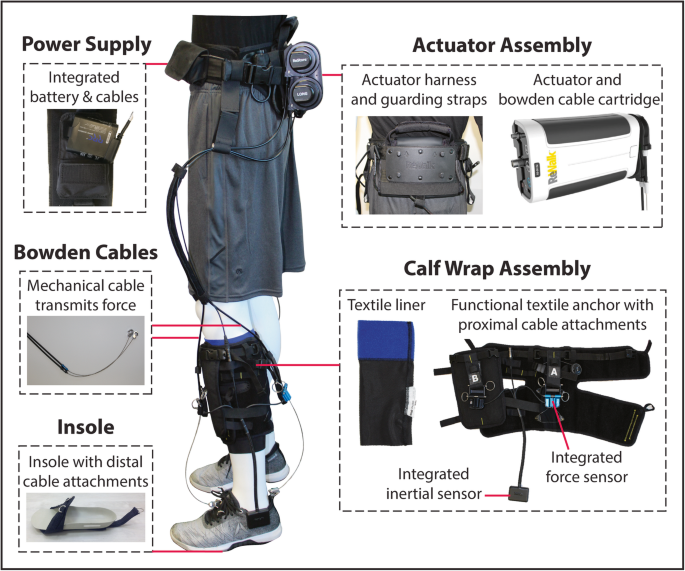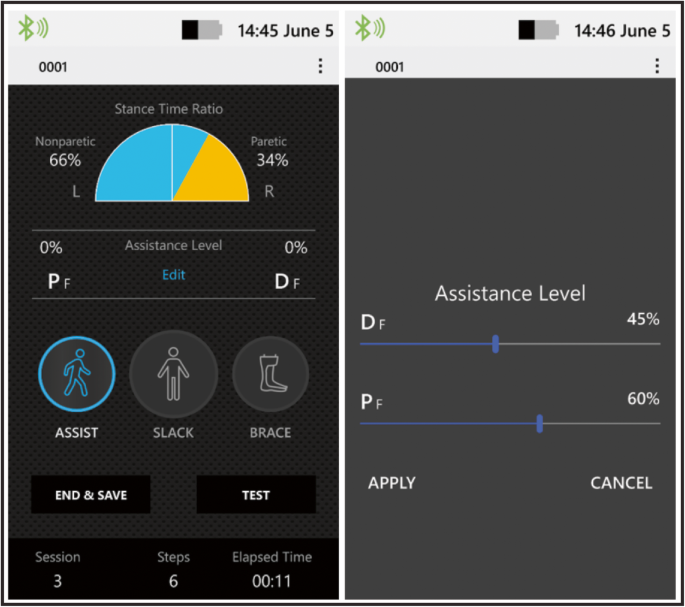Abstract
Background
Atypical walking in the months and years after stroke constrain community reintegration and reduce mobility, health, and quality of life. The ReWalk ReStore™ is a soft robotic exosuit designed to assist the propulsion and ground clearance subtasks of post-stroke walking by actively assisting paretic ankle plantarflexion and dorsiflexion. Previous proof-of-concept evaluations of the technology demonstrated improved gait mechanics and energetics and faster and farther walking in users with post-stroke hemiparesis. We sought to determine the safety, reliability, and feasibility of using the ReStore™ during post-stroke rehabilitation.
Methods
A multi-site clinical trial (NCT03499210) was conducted in preparation for an application to the United States Food and Drug Administration (FDA). The study included 44 users with post-stroke hemiparesis who completed up to 5 days of training with the ReStore™ on the treadmill and over ground. In addition to primary and secondary endpoints of safety and device reliability across all training activities, an exploratory evaluation of the effect of multiple exposures to using the device on users’ maximum walking speeds with and without the device was conducted prior to and following the five training visits.
Results
All 44 study participants completed safety and reliability evaluations. Thirty-six study participants completed all five training days. No device-related falls or serious adverse events were reported. A low rate of device malfunctions was reported by clinician-operators. Regardless of their reliance on ancillary assistive devices, after only 5 days of walking practice with the device, study participants increased both their device-assisted (Δ: 0.10 ± 0.03 m/s) and unassisted (Δ: 0.07 ± 0.03 m/s) maximum walking speeds (P’s < 0.05).
Conclusions
When used under the direction of a licensed physical therapist, the ReStore™ soft exosuit is safe and reliable for use during post-stroke gait rehabilitation to provide targeted assistance of both paretic ankle plantarflexion and dorsiflexion during treadmill and overground walking.
Introduction
Bipedal locomotion is characterized by alternating periods of single and double limb support, with ground clearance by the swing limb and propulsion by the trailing stance limb serving as crucial walking subtasks [1, 2]. Healthy individuals are able to generate an ankle dorsiflexion moment during each limb’s swing phase to lift the foot and facilitate ground clearance. They are also able to generate an ankle plantarflexion moment during each limb’s late stance phase to produce the propulsive force required to advance the limb and body [3]. In contrast, post-stroke hemiparesis results in impaired paretic dorsiflexion and plantarflexion that, in turn, hinders ground clearance and propulsion [4,5,6,7,8] and, ultimately, necessitates compensatory walking strategies [9, 10] that make walking more effortful and unstable [11,12,13,14].
The ReWalk ReStore™ is a soft robotic exosuit designed to augment the paretic ankle’s ability to produce both dorsiflexor and plantarflexor moments during walking. In early proof-of-concept studies conducted with a research version of the device [15, 16], exosuits were shown to facilitate immediate increases in swing phase paretic ankle dorsiflexion by an average 5 degrees [17], the propulsion force generated by the paretic limb by an average 10% [17], and the positive center of mass (COM) power generated by the paretic limb during late stance phase by an average 22% [18]. Together, these improvements in paretic limb function resulted in reduced propulsion asymmetry by 20% [17] and the asymmetry in positive COM power generated during late stance phase by 39% [18]. Also observed were immediate reductions in hip hiking and circumduction compensations of over 20% [9], reductions in the energy cost of walking by an average 10% [17, 18], faster overground walking speeds by a median 0.14 m/s, and farther walking distances during the 6-min walk test by a median 32m [19].
Building on this foundational biomechanical, physiological, and clinical research, the objective of this multi-site clinical trial was to evaluate safety, feasibility, and reliability of using exosuits during post-stroke rehabilitation in preparation for a commercial clinical application to the United States Food and Drug Administration (FDA). In contrast to previous laboratory-based research that studied the immediate effects of exosuit prototypes on clinical, biomechanical, and physiological outcomes, this translational research sought to determine the safety of clinicians and patients with post-stroke hemiparesis using the commercially-adapted ReStore™ in clinical settings, the feasibility of clinician operators applying the ReStore™ during both treadmill and over ground gait training activities, and the reliability of the technology across multiple training visits. In addition to outcomes of safety, feasibility, and device reliability, an exploratory evaluation of the impact that multiple training visits with the device have on users’ maximum walking speeds, both with and without the device, was also included.
Methods
The ReStore™ is indicated for use by individuals with post-stroke hemiparesis undergoing stroke rehabilitation under the supervision of a licensed physical therapist. To assess the safety, device reliability, and clinical feasibility of using the ReStore™ during post-stroke gait rehabilitation, a multi-site trial was conducted. The trial included five clinical sites and 44 users with post-stroke hemiparesis. The study was approved by the Institutional Review Boards of Boston University, Spaulding Rehabilitation Hospital, The Shirley Ryan AbilityLab, TIRR Memorial Hermann Hospital, Kessler Rehabilitation Hospital, and Moss Rehabilitation Hospital. Written informed consent was secured for all participants.
Study inclusion and exclusion criteria
Study participant eligibility requirements consisted of: (i) one-sided ischemic or hemorrhagic stroke, (ii) > 2 weeks post-stroke, (iii) age > 18 years, (iv) height between 4′8″ and 6′7″, (v) weight < 264lbs, (vi) medical clearance, (vii) ability to ambulate at least 5 ft without an AFO and with no more than minimal contact assistance, (viii) ability to follow a 3-step command, (ix) ability to fit suit components, (x) no greater than 5 degrees of ankle plantar flexion contracture, and (xi) Modified Ashworth Scale for tone at 3 or less for ankle dorsiflexor and plantarflexor muscles. Exclusion criteria included: (i) severe aphasia limiting ability to express needs or discomfort verbally or non-verbally, (ii) serious co-morbidities that interfere with ability to participate, (iii) significant Peripheral Artery Disease, (iv) colostomy bag, (v) current pregnancy, (vi) uncontrolled hypertension, (vii) participation in any other clinical trial, (viii) open wounds or broken skin at device locations requiring medical management, (ix) urethane allergies, (x) and current DVT.
Study overview
After screening and enrollment, study participants completed up to two walking evaluations and five device exposure visits. Each exposure visit consisted of up to 20 min of overground walking practice and 20 min of treadmill walking practice while receiving assistance from the device. The visit schedule consisted of a minimum of two visits per week, with the expectation of no more than 4 weeks between the pretraining and posttraining evaluations. Actual activities and durations were dependent on each study participant’s abilities as determined by the treating physical therapist as per their usual practices. The target level for plantarflexion assistance during all active walking with the ReStore™ was 25% of the user’s bodyweight [17, 19]. The target level for dorsiflexion assistance was the minimum needed for adequate ground clearance and heel strike, as determined visually by the physical therapist.
Device overview
The exosuit consists of motors worn at the waist that generate mechanical forces that are transmitted by cables to attachment points located proximally on a functional textile worn around the calf and distally on a shoe insole (Fig. 1). The overall weight of the exosuit is approximately 5kgs, with the vast majority of the weight located proximally in the actuation pack worn at the waist. Each functional textile contains a detachable liner that can be washed. For users who require medio-lateral ankle support in addition to ankle plantarflexion and dorsiflexion assistance, an optional textile component that prevents ankle inversion without restricting dorsiflexion and plantarflexion can also be used. Inertial sensors that attach to a patient’s shoes measure gait events and automate the independent timing of the active ankle plantarflexion and dorsiflexion assistance provided by the ReStore™ as previously described [16]. Load cell sensors located at the end of each cable are used to monitor the interaction between user and exosuit and ensure that the target level of assistance is achieved [16, 17]. A hand-held device with a graphical interface allows clinicians to monitor patients’ performance and select and progress, in real-time, the assistance parameters (Fig. 2).


[…]
Continue …
